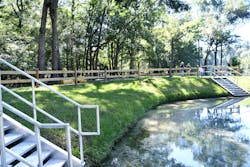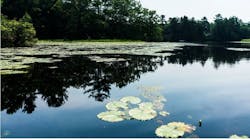Ryan Leeds is managing partner of SOX Erosion Solutions. Leeds can be reached at [email protected].
undefinedShoreline Erosion Improvements at Rum Park
As hurricanes, heavy rains and violent storm surges become the norm, focus on safety measures is gradually shifting to inland communities.
While most of the attention has centered on coastal areas, it is becoming more apparent that water is being pushed inland and causing significant damage many miles from the coast. We see this as storm-ravaged areas on the Gulf Coast that have been affected by numerous weather events in 2020. A recent study from Scientific Report clearly indicates that rising oceans, powerful coastal storms and high tides are reaching further inland.
The drastically fluctuating water levels cause dangerous conditions that include the erosion of shorelines along lakes and rivers. This dilemma is not strictly reserved for communities, parks and golf courses near the ocean. Rum Island Park, a recreational facility in Fort White, Florida, attracts thousands of visitors annually who enjoy the pristine springs along the scenic Santa Fe River and opportunities for canoeing, boating, swimming, snorkeling and fishing.
This destination was deemed unsafe by numerous government agencies due to collapsing, unstable land that put visitors and those operating heavy equipment in peril. Heavy rainfall, rising water levels and constant foot traffic were among the major causes of this erosion. In several instances, erosion caused up to 5-foot drop-offs from sidewalks and severely compromised handicapped access. Environmental consultants also noticed that sediment had built up around the vents, reducing water flow and volume.
Due to these situations, Rum Island Park was closed in early 2020. The Suwanee River Water Management District, Department of Environmental Protection and Army Corp of Engineers agreed that a total renovation of the park was required to restore this popular destination. The centerpiece of this renovation was the restoration of shorelines. As with all government projects, officials wanted an affordable, long-lasting solution that could be installed quickly.
After considerable research, these government agencies turned to SOX Erosion Solutions, a designer and developer of bio-engineered living shorelines and hillside stabilization erosion control systems. The firm offers a suite of patented systems including DredgeSOX, ShoreSOX and SOXFence that have been deployed to restore the shorelines along rivers, canals and lakes. The SOX systems combine technology, engineering and bio-science to produce an environmentally responsible solution.
Both DredgeSOX and ShoreSOX involve filling a large knitted mesh shoreline restoration system with organic sediment dredged from lake bottoms or locally sourced soils delivered to the job site. It is then secured to the shoreline, using the patented anchoring systems to recreate the original and now living shoreline. These systems can be installed in a matter of days and are less expensive than alternatives.
The engineers drew up a plan for total restoration and reclamation of the spring and adjacent park area. The erosion control product creates a safer, environmentally friendly and natural looking area for every day public recreational use. It has additional benefits that include dredging and re-purposing sediment from the river bottom that was clogging the spring vents and limiting water flow. The patented mesh system also serves as a filter, reducing sub-surface runoff nutrient overload from entering the water. These combine to improve the habitat for wildlife.
After a few days of dredging, the excess sediment from the adjacent spring vent was funneled into the mesh. Proper adjustments were made to match the desired slope and grade from the engineering plans. Once in place, sod was brought in and installed through the system using biodegradable stakes. The high-density knitted mesh of the material allows new vegetation to root to ensure long-lasting shoreline stability.
Lake and Wetland Management, a Florida-based environmental resource company, and Bluewater Environmental, a Certified Service Provider for the SOX systems, combined installation efforts for this project. The following are highlights of the restoration project:
- Dredging the spring bottom cleared the spring vents, thereby increasing vent flow.
- Significant collapsed shoreline was re-claimed. In some areas, up to 25 feet of land sloping to the water was recovered.
- Recreated a “living shoreline” that was more affordable and safer than other alternatives, such as placing large boulders or building seawalls along the shore. These hardened structures frequently fall into bodies of water.
- Created an eco-friendly “living shoreline” that restored the spring area shorelines to their natural states.
- The dredging process improved water flow, reduced water pollution and created healthy habitats. It also removed years of accumulated leaves, grass clippings and other decaying organic matter from lake bottoms.
- Once in place, the system stabilized the shoreline as grass, sod and other vegetation roots through the mesh armoring, establishing a new, healthy green space.
- DredgeSOX filtrates and improves water flow, creating healthy wildlife habitats, reducing invasive plant species and improving the natural balance both in the water and out. As a sub-surface water filter, the mesh reduces phosphates, nitrates and other pollutants from entering the river. The improved water quality enhances the overall eco-system.
The project was successful as the shorelines at Rum Island Park were fully restored to their original beauty. The stabilized land gave sidewalk pedestrians and disabled visitors a safe experience. In addition, swimmers and fishermen now have safe and easy access to the rivers. Park officials also noticed significantly increased water flow from the spring vents.
The county park is now a safe, environmentally healthy and a beautiful place for the public to use.
It is crucial to recognize that the situation at Rum Island Park is not an isolated incident. As weather patterns change and storm surges become more prevalent, inland communities and facilities will be affected. Many of these cities are taking notice and making significant strides to protect residents and valuable land from the effects of high tides and storm surges that are initiated many miles away.
The project at Rum Island Park is one of a growing number of initiatives that are becoming more common among inland communities.






